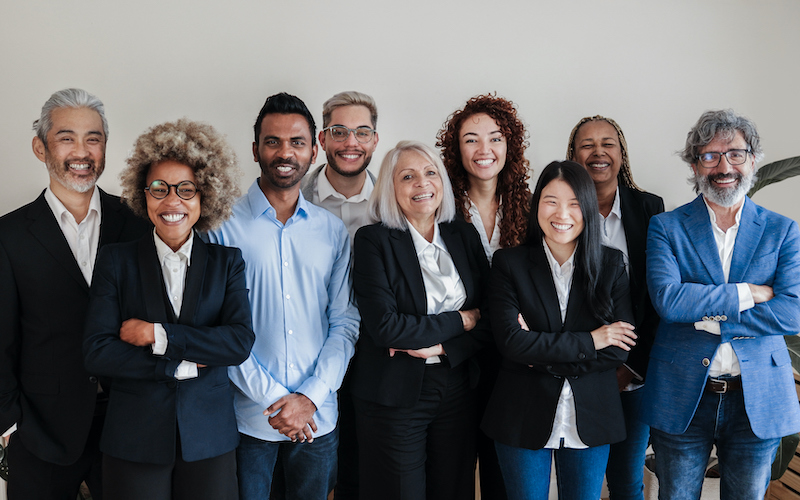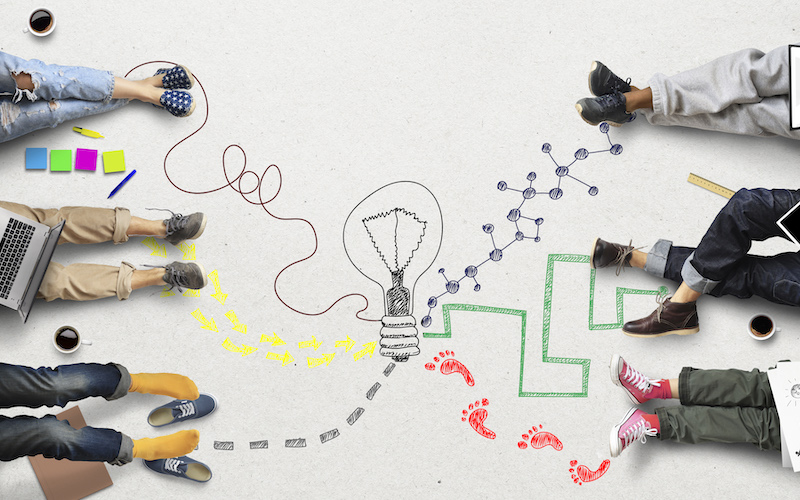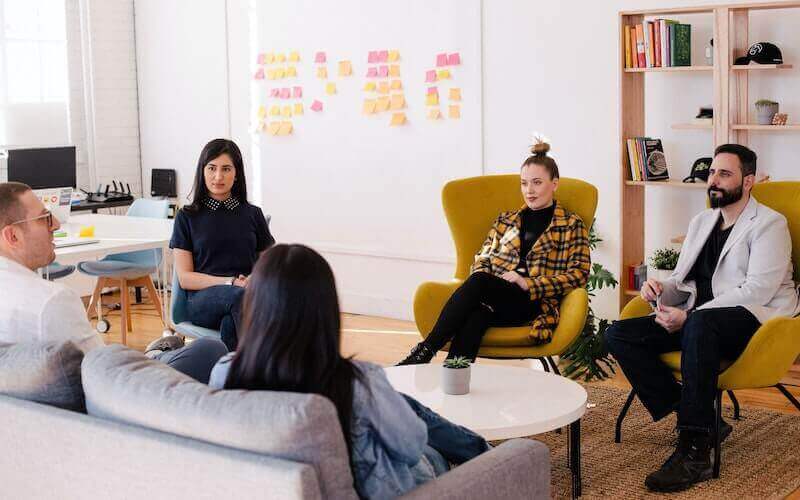Introduction to Inclusive Leadership
Training to build the foundation of a diverse, innovative, and productive workplace culture.Today’s leaders must be able to effectively communicate and build trusting work relationships with many different kinds of people. We are moving from the era of “command and control” to an era of “engage and include.”

Some individuals have a natural ability to feel comfortable with many different types of people and can easily build camaraderie within their teams. Others are comfortable exhibiting inclusive behaviors themselves but have difficulty coaching and developing these skills among those who report to them. And still others have difficulty establishing comfortable working relationships with specific people or groups.
According to the Gallup Organization, disengaged (exclusive) managers are three times
more likely to have disengaged and actively disengaged employees, costing businesses
billions of dollars in lost revenue each year. If you are working to create a culture that values all employees and is inclusive of differences, your leaders must understand what inclusion is, how it is achieved and what specific behaviors and actions they can take to promote the culture you desire.
Inclusity’s Introduction to Inclusive Leadership Workshop (or series) provides your supervisors, managers, and leaders the personal insight and awareness, knowledge and skills they need to become the best and most inclusive leader possible.
In this four-, eight-, or 12-hour workshop (or series of shorter workshops if desired) we introduce your leaders to up to four Inclusity Models and the tools they need to actively become inclusive leaders.
Learning Objectives:
- Participate in and lead small group discussions about the factors that define their team members, in order to build trust and open communications
- Understand the attitudes and behaviors that create exclusion
- Identify situations in which team members are being excluded
- Increase their commitment to actively include instead of unintentionally excluding
- Utilize models presented during the training to intentionally create more inclusive workplace teams
From The Inclusity Blog

A Culture of Inclusion Starts at the Top
Building a culture of inclusion begins when leadership is on board. Their commitment is essential to sustaining a positive culture in the long run.
Although the responsibility for inclusion sits on the shoulders of the CEO, the only way for any diversity and inclusion program to survive and be effective is through leadership commitment. When employees see the behaviors and actions of inclusive leaders, they will be more engaged and productive, helping to grow and contribute to a workplace that is inclusive. Now that why know why it’s important, let’s ask the next logical question: how can you promote an inclusive company culture starting from the top?
How to Build a Culture of Inclusion
Build relationships. An inclusive culture requires a solid foundation of trust. By making efforts to authentically connect with employees and ensure psychological safety for them, leaders can build trust. When employees trust their leadership, they are more likely to share exciting and new ideas, as well as offer fresh perspectives that may have otherwise gone unheard.
Own it. Diversity and inclusion are often treated as a single initiative owned exclusively by HR; however, only when leadership steps up to own and drive diversity and inclusion will a company’s diversity and inclusion practices thrive. Leaders should be the first to role model inclusive behavior, and this will allow employees to feel safe enough to do the same.
Hold inclusion training for leaders. Don’t assume that leaders understand what it means to be inclusive; take the initiative and educate them how to cultivate an inclusive culture. Through inclusion training, they can grow emotional intelligence and better understand unconscious bias, giving them the confidence and skills to make fast, efficient and effective decisions as a people leader.
Practice inclusive leadership. Inclusive leaders actively seek out and consider different perspectives to inform their decision-making. This enables them to collaborate more effectively with others, facilitate constructive conversations, give actionable feedback, and act upon the advice of diverse employees. Leaders should be inclusive of the multiple viewpoints, perspectives and styles that are a part of diverse teams. Inclusive leadership makes diversity matter.
Form an inclusion council. One of the first steps you can take toward establishing a more inclusive organizational culture is to establish an inclusion, diversity, and equity (IDE) council/taskforce. These groups can be involved in goal-setting around hiring, retaining and advancing a diverse workforce and in furthering other IDE efforts. Carefully select employees (including leaders) who are not only passionate about building a diverse and inclusive organization, but also have the respect and trust of your people.
Hold leaders accountable. Make inclusion a core value of the organization — not just something you do to “check a box.” Increase accountability by tying a portion of leaders’ bonuses to diversity and inclusion goals. This sends a strong signal that the company takes the goals seriously. It also pushes leaders to be accountable for their behaviors.
Representation matters. Women and people from marginalized groups are still underpaid and underrepresented in higher level positions compared to their white, male counterparts. Employees should see diversity represented in senior leadership. While finding ways to attract diverse leaders is important, an inclusive culture will help retain that diversity.
No diversity and inclusion efforts and initiatives will be successful without buy-in from leadership. As with any culture change, if you want to develop a culture of inclusion, you must start from the top of the organization. Inclusive leadership is the key to not just creating a culture of inclusion; it is one if the most a crucial elements in fostering an innovative and productive workforce. If you’re interested in working with your leadership to foster a culture of inclusion, Inclusity is here to help.

Age Is More Than a Number: Embracing Generational Diversity
For the first time in history, there are five generations of employees in the workforce. From seasoned Traditionalists with years of experience to Generation Z-ers, workplaces are becoming increasingly varied by age.
Because of the spectrum of ages, differences in the workplace can range from differences in beliefs to differences in working styles. Managing a multigenerational workforce with many potential different perspectives, experiences, values, and goals poses a unique challenge. The goal is to make our teams cohesive, regardless of their members’ age, understanding that no generation is better than any other and valuing other generations’ strengths and what ours might lack.
What exactly is generational diversity?
Often, when companies focus on improving diversity, they focus on gender, sexual orientation, or ethnicity. However, age and generations are also forms of diversity in the workplace. And generational diversity should be embraced, celebrated, and fostered with inclusion and belonging.
When you work to create generational diversity in your workplace, it means that a wide range of generations are represented within your organization. You may be working alongside colleagues from several different generations, including:
- Traditionalists or The Silent Generation (1928-1945)
- Baby Boomers (1946-1964)
- Gen X (1965-1980)
- Millennials (1981-1996)
- Gen Z (1997-2012)
To manage a workforce spanning multiple generations, the organization can help each generation understand one another and overcome ageism, unconscious bias, and stereotypes. These generational biases can harm workplace relationships when differences are used to stereotype and label others due to their age. However, appreciating the generational perspective will lead to greater inclusion and less unconscious bias.
Why does generational diversity matter?
While every individual is different, there are some common differences in how people born at different times perceive their work and their workplace. Understanding these differences can help you identify what may be causing conflict and find ways to resolve it. Understanding each other’s views and values will also allow different generations to increase their appreciation of one another. When people feel heard, understood, and valued, this leads to better communication, collaboration, and inclusion.
Truth is, we need people of all generations to make organizations effective. You want the “getting the job done” attitude of the Traditionalists, the teamwork skills of Baby Boomers, the self-reliance of Generation X, the multitasking abilities of Millennials, and the entrepreneurship of Generation Z. Combined, these qualities create a mixed, high-performing team.
How to embrace generational diversity?
Although organizations benefit from the talents, interests and desires of employees from multiple generations, ensuring those differences are recognized, understood and appreciated requires intention and effort. Here are ways organizations can create community among generations while establishing a diverse and inclusive culture.
Avoid making age-based assumptions and stereotyping. To take full advantage of your multigenerational workforce, avoid making assumptions or stereotyping based on age. Instead, talk to each of your employees and learn about their individual preferences and working styles. Stereotypes such as “he’s too old to learn a new computer program” or “she’s too young to lead a team” can be limiting and counterproductive.
Encourage various working styles. In the workplace, different generations can have vastly different work styles. This could stem from a variety of reasons, such as technology and education. As the workforce becomes more diverse, it is important to acknowledge and understand these differences.
Focus on commonalities. An organization with positive generational diversity in the workplace doesn’t focus on the things that keep generations separated, instead focusing on what we all have in common.
Adapt your communication style. There are likely differences in preferred communication styles between the generations. Think of multiple ways to communicate your message. Using multiple communication streams can foster an inclusive culture.
Create opportunities for cross-generational mentoring. Creating a mentoring relationship where generations share their experiences, skills, and work practices helps individuals become familiar with each generation’s differences and strengths. This mutual understanding can help bring these generations closer together and create a more positive and productive work environment.
By understanding each generation’s value, employers can create an inclusive environment where everyone feels appreciated and respected. The more inclusive you can be, the more likely you’ll build a cohesive group that supersedes generational stereotypes. If you’d like support building an inclusive workplace culture, check out Inclusity’s training programs.

The Enneagram: How this Personality Assessment Can Cultivate Inclusion
Understanding different personality types can further broaden appreciation of all kinds of different people. At Inclusity, we use a tool called the Enneagram to connect people across all dimensions of diversity and create greater cohesion and inclusion. Kipp Leyser, Vice President of Coaching at Inclusity, has been coaching on the Enneagram for over 30 years. He shares: “In today’s competitive world, we need to be able to think out of the box. One way to think out of the box is to acknowledge the many different personality styles that see the world from different perspectives.”
What’s the Enneagram?
The Enneagram is an ancient framework that people use to analyze a spectrum of personality types. A personality assessment designed to help people better understand themselves and others, the Enneagram identifies nine unique ways of being and relating to others. A person’s personality generally fits in one of nine personality types, each of which are inclusive on one’s beliefs, values, and motivations. The Enneagram maps out each types’ automatic patterns of thinking, feeling, and behaving and provides insight into how to relate more effectively to others.
Further dividing each of the nine types into three subtypes, the Enneagram defines 27 different ways of looking at the world and experiencing the world. Humans are complex, and people don’t fit neatly into categories. But by seeking to define and illuminate themes in people’s personalities, we can actually better understand and appreciate diversity.
How does the Enneagram connect with Inclusion?
At work, each personality type brings something important and unique. Not acknowledging and valuing people’s individual perspectives can shut people down and ultimately lower engagement and productivity. The Enneagram can be used to create a more inclusive workplace where each team member is valued for their perspective and attributes. It helps us to harness the best skills of each individual. “If you understand what others pay attention to, what they value, and what’s important to them, this contributes to the greater whole and a deeper holistic experience,” says Kipp.
By nature we tend to limit ourselves to the belief that our point of view is the only right one. The Enneagram as well as other personality assessments connect people, encouraging them to become more open and accepting of the various ways people move through the world. If we can understand others’ points of view, we can better include everyone and not feel the need to defend or resist.
Personality diversity is key to a balanced, productive workplace. By understanding the Enneagram types, we gain greater insight into our own and our teammates’ strengths and challenges, and how we interact with one another based on type. If you’d like more information on how you can use the Enneagram to maximize the benefits of differences in your organization, learn more about our Personality Insights Workshop.

White Men as Inclusion, Diversity, & Equity (IDE) Partners
In this blog, we hear from Patrick Hughes, a facilitator with Inclusity. He openly shares his perspective as a white male in the IDE space; he fits into almost every in-norm, dominant social identifier in our society. Patrick addresses the “elephant in the room” right upfront: ”Hi, I’m Patrick. I’m a white guy with a lot of privilege, and I’m fully committed to inclusion.”
How did you first get involved in inclusion, diversity, & equity (IDE)?
My journey began about 13 years ago when I was completing a master’s program in organizational development. One of the courses was called “Use of Self as an Agent of Change.” We spent a week looking at social identity theory and how who we are impacts our ability to work with organizations, individuals, and teams. This was my first exposure to concepts related to IDE. This was the first time that anyone told me that all of my social identifiers and who I am walking around unconsciously impacts others, potentially in a negative way.As a white male, what role do you play in IDE efforts?
I see myself as a partner, ally, and interrupter. I look at my role as partnering up with other people to make things happen, not leading the charge. I’m constantly looking at how I can be an ally for any marginalized group because I live in so many privileged categories and in-norm groups. I’m looking for ways to partner with or be an ally to folks that aren’t in-norm groups, so I can create inclusion. Also, because of this awarded privilege that I sometimes have, I look for ways to interrupt conversations that may be creating exclusion. I think about how I can use the voice that I’m given because of my gender and skin color to elevate others.
What are some of the lessons learned from engaging in IDE work?
I’ve learned a lot around how to be empathetic and how to hear and value others’ emotions and experiences. When I work with individuals and groups, I want to hear feedback so I can grow and create safe space where we can have relationship and dialogue. I’m not reluctant to initiate and engage in difficult conversations. Through the difficult conversations come strengthened partnerships and new insights. But, this must be authentic. If you engage in this way and don’t mean it, you’ll do more harm than good.
How do we engage white males in IDE efforts?
We need to disarm white men and create a safe space for them to share emotions around feeling excluded in IDE. If we don’t validate their experiences and feelings around exclusion, the overall objective of ensuring that everyone feels connected and valued will fail. White men need to see themselves as part of the solution – not part of the problem where they feel blamed and vilified.
What have you personally gained from working in the IDE space?
I’ve gained a richer life experience and deeper relationships. I’ve gained new perspectives that enable me to be a better leader. I now walk around this world from a conscious place as opposed to unconsciously through my socializations. The socializations and biases that I grew up with are not who I want to be in the world. For me, creating inclusion is creating the world that I want where everyone feels valued and empowered. Previously, I thought I was creating the world I wanted only to realize that there’s unconscious bias getting in the way of that. I wanted to create empowered teams and be a leader that everyone loved and admired, but I wasn’t. I was exhibiting behaviors that were contrary to what I wanted to create.
Why are diversity and inclusion everyone’s responsibility, including white males?
We cannot build inclusion if we’re excluding anyone. White men absolutely need to be at the table. They have the opportunity to leverage much of the power and privilege that they have been given to further the efforts of creating inclusion to benefit everyone. However, white men must be willing to step into uncomfortable situations and embrace change to make this happen. It can feel scary because the world has been set up to benefit them, so why should they want to change. Sometimes you have to risk a little bit to gain a lot. Once I was willing to risk alienating some friends and colleagues or being seen as a traitor or outcast, I found a whole new world open up to me on the other side. That world of inclusion now entails deeper relationships, more productive teams, and exponential growth in my leadership abilities.

5 Things to Consider When Evaluating A Company’s Culture for IDE
So, your organization has decided to make inclusion, diversity, and equity (IDE) a priority. We know IDE culture change is a complex process, and every organization’s journey is unique. However, no matter where you are on your roadmap for developing an IDE program, a culture assessment is the foundational point for an effective IDE initiative.
A culture assessment provides companies with qualitative and quantitative data on their culture, leadership, and equity, including a deep understanding of the views of its workforce and how they experience the organization. A comprehensive culture assessment may include a climate survey (qualitative employee survey), focus groups, leadership interviews, and/or policy review.
A culture assessment identifies areas of opportunity and specific challenges in your organization’s IDE journey to create a strategy for meaningful change. “We want to broadly understand the culture, because we want to do work that aligns with the existing culture,” Mitchell Campbell, Director of Research and Evaluation for Inclusity, shares. “A cultural assessment helps identify an organization’s challenges but also helps us identify positive aspects of culture that we can enhance through the work that we do.”
Inclusity has helped leading companies assess and improve their inclusion and diversity efforts through our comprehensive approach and tailored solutions. Here are some tips to consider when evaluating a company’s culture for IDE:
Measure inclusion, not diversity. One misstep companies take is measuring diversity and mistaking it for inclusion. A company may employ a diverse workforce, but unless diverse employees feel safe, welcomed, and valued, the organization is not inclusive.
Don’t just ask questions about inclusion. When asking questions only about inclusion, you only see part of the picture. Address all the elements of the culture and not just questions about inclusion, even if at face value the question doesn’t sound like it has anything to do with inclusion. For example, asking if leaders are accessible can offer insight about how inclusive an organization is.
Be inclusive of everyone’s perspective. Make sure to talk with individuals at all levels of the organization. Only talking with leaders may give a skewed perspective of the organization. You need the perspective of everyone in the organization, including those in entry level roles and people who are new to the company.
Use a broad definition of diversity. When people think about diversity, they typically think about race, gender, and maybe sexual orientation. You also want to consider things like how long someone has been with the organization, what department someone works in, whether someone is a remote employee, etc. All of these different aspects of someone’s identity in their work role can have an effect on how included they feel, and thus are also important aspects of diversity.
Capture both strengths and challenges in the existing culture. Our instinct is to focus on what’s not going well because that is what we need to change. It’s equally important to focus on strengths of the organization, such as what makes people feel included, because this information helps us to understand what leads to the experience of inclusion within an organization. We can then capitalize on those existing strengths to expand inclusion to others in the organization as well.
Once an IDE culture assessment is complete, it can provide insights to set your organization up for achieving a culture of inclusion. This includes existing strengths that can be capitalized on, existing challenges that need to be addressed, specific social identities that need to receive more or less attention in the inclusion effort, examples about what makes people feel included, and concrete recommendations that can often provide quick wins.
Mitchell uses a medical metaphor to explain the importance of a culture assessment. “When we don’t do a climate assessment, we’re doing the WebMD version of medicine,” he says. “But when we do a climate assessment, we’re doing an in-depth assessment that helps us to better understand the condition and then make specific diagnosis and treatment.”
Contact Inclusity to learn more about how to get feedback from your employees and start taking action to transform your culture and foster equitable and inclusive workplace practices in your organization.


